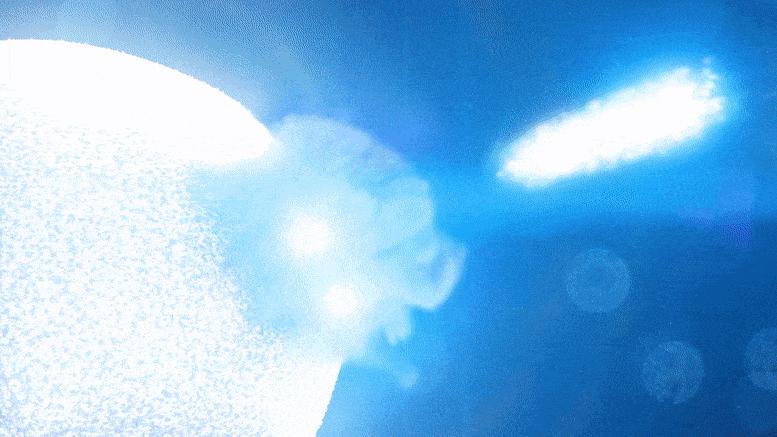
Normally jets from collapsing stars produce gamma rays for many seconds to minutes.
Astronomers think the jets from GRB 200826A were shut down quickly, producing the shortest gamma-ray burst (magenta) from a collapsing star ever seen.
Credit: NASA’s Goddard Space Flight Center/Chris Smith (KBRwyle).
On August 26, 2020, NASA’s Fermi Gamma-ray Space Telescope detected a pulse of high-energy radiation that had been racing toward Earth for nearly half the present age of the universe.Lasting only about a second, it turned out to be one for the record books – the shortest gamma-ray burst (GRB) caused by the death of a massive star ever seen.
They observe long bursts in association with the demise of massive stars, while short bursts have been linked to a different scenario.
Astronomers combined data from NASA’s Fermi Gamma-ray Space Telescope, other space missions, and ground-based observatories to reveal the origin of GRB 200826A, a brief but powerful burst of radiation.
It’s the shortest burst known to be powered by a collapsing star – and almost didn’t happen at all.
Credit: NASA’s Goddard Space Flight Center.
“We already knew some GRBs from massive stars could register as short GRBs, but we thought this was due to instrumental limitations,†said Bin-bin Zhang at Nanjing University in China and the University of Nevada, Las Vegas.“This burst is special because it is definitely a short-duration GRB, but its other properties point to its origin from a collapsing star.
Now we know dying stars can produce short bursts, too.â€.
The second, led by Tomás Ahumada, a doctoral student at the University of Maryland, College Park and NASA’s Goddard Space Flight Center in Greenbelt, Maryland, describes the GRB’s fading multiwavelength afterglow and the emerging light of the supernova explosion that followed.
When a star much more massive than the Sun runs out of fuel, its core suddenly collapses and forms a black hole.Following the burst, the disrupted star then rapidly expands as a supernova.
Fermi observations recently helped show that, in nearby galaxies, giant flares from isolated, supermagnetized neutron stars also masquerade as short GRBs.
After traveling for eons through the expanding universe, the signal had stretched out to about one second long when it was detected by Fermi’s Gamma-ray Burst Monitor.
Within a day of the burst, NASA’s Neil Gehrels Swift Observatory discovered fading X-ray emission from this same location.But to prove this short burst came from a collapsing star, the researchers also needed to catch the emerging supernova.“If the burst was caused by a collapsing star, then once the afterglow fades away it should brighten again because of the underlying supernova explosion,†said Leo Singer, a Goddard astrophysicist and Ahumada’s research advisor.The astronomers imaged the host galaxy in red and infrared light starting 28 days after the burst, repeating the search 45 and 80 days after the event.
The researchers suspect that this burst was powered by jets that barely emerged from the star before they shut down, instead of the more typical case where long-lasting jets break out of the star and travel considerable distances from it.If the black hole had fired off weaker jets, or if the star was much larger when it began its collapse, there might not have been a GRB at all.
The researchers conclude that collapsing stars producing short GRBs must be marginal cases whose light-speed jets teeter on the brink of success or failure, a conclusion consistent with the notion that most massive stars die without producing jets and GRBs at all.“A peculiarly short-duration gamma-ray burst from massive star core collapse” by B.-BJ“Discovery and confirmation of the shortest gamma-ray burst from a collapsar” by Tomás Ahumada, Leo PRThe Fermi Gamma-ray Space Telescope is an astrophysics and particle physics partnership managed by NASA’s Goddard Space Flight Center in Greenbelt, Maryland.Space
Would not expect this kind of cheap and misleading headline coming out of Goddard